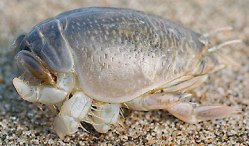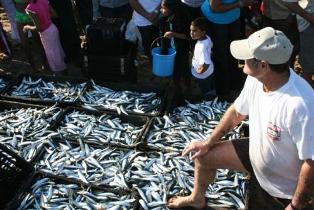Bloodworms
Bloodworms are collected by pumping sand and then the worms are forced
to the surface. Bloodworm is a favourite bait when targeting White
Steenbras and Kob (Kabeljou), but many other fish find it irresistible.
There is an advantage to using bloodworm as they are difficult to
remove from the hook. Once caught bloodworm need to be cleaned before
being used or stored. This is done by cutting off the thin tail part
and squeezing out the body contents and sand by running your thumb and
forefinger from the head downwards.
Earthworms are similar to bloodworms, but bloodworms work best for saltwater fishing.
Once cleaned bloodworm should be
used or they can be individually wrapped and in clingwrap and be put in
the freezer.
Mole Crabs

Mole Crabs, commonly known as sea lice mainly occur in Northern
Kwazulu-Natal and there are strict regulations that control their
capture. They are caught during low tide on a flat stretch of beach.
Wait for a wave to roll back and then look for V shapes in the sand.
These are the marks of the sea lice burrowing into the sand. Run to the
marking and with both hands collect a handful of the sand. Close your
hand around it and place the sand into a bucket. Then check if you
caught him.
Sea lice will live for some time in sea water, but they are most
effective when alive. They are excellent bait for species such as a
Pompano, which feed close inshore near sandy beaches.
Sardine
(pilchards)

Sardines
are used by almost every
angler, where off the shore or on a boat. Sardines can be used in
various ways from a whole fish to cutting them into different sizes
depending on the species you are targeting. Sardines are also cut up
into small pieces and along with other fish pieces this can be used to
create a chum line to attract larger fish.
The best time to collect sardines is during the sardine run which
happens during June/July. This spectacular event is the migration of
millions of sardines. Sharks, Dolphins and large gamefish follow these
massive shoals of bait fish and they have a fest. During this time
anglers catch their share using cast nets or they purchase a crate full
from the seine netters.

A seine netter with his share of the sardine run.
Tip:
Make sure that when buying sardines that they are not yellow or the
skin is crinkled. If so this will mean that they have been defrosted at
least once and they will not be fresh.
Also See:
|